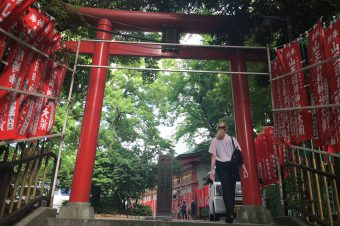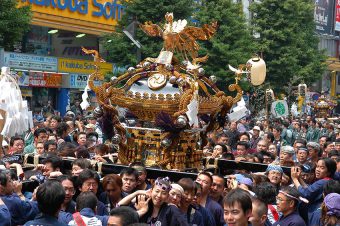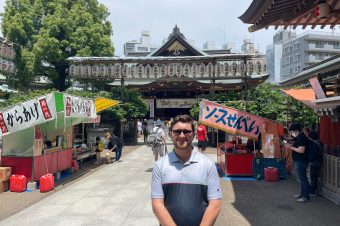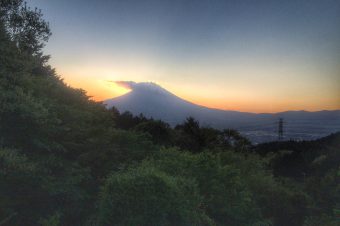We were welcomed at the Nichirenshu Saichuzan Joshoji by Itou-sensei, who was the head priest of the temple as well as master of the aikido dojo connected to the temple and shown to the main prayer hall. As we entered the hall, the same indescribable silence as the one in other temples and shrines greeted us, as though the outside world knew better than to intrude in this sacred place. Many of them were beautiful, but Saichuzan’s hall was more elaborate and decorated with gold detailed reliefs of lions and dragons, as well as what we were informed were 800-year-old large paintings of Nichiren‘s life story, the Buddhist priest responsible for founding this school of Buddhism.


Next, he showed us an alter to the right side of the main altar where the statue Kishibojin, also known as Hariti in Indian Sanskrit, was placed. Kishibojin is believed to be the most powerful kami in the Nichiren school of Buddhism. She is also known as a protector of children; from their conception to their safe delivery to their healthy growth, the ‘children’ even return to ask for help with their studies, exams, getting hired, marriage. So, they have visited and worshiped to be protected by Kishibojin. This was a new development for me, since most of the time, Buddhism is equated to funeral rites and ceremonies, though it seems that this school, or at least this temple in specific, is involved in all aspects of people’s lives.



The statue itself came from Edo Castle when it burned down in 1873 and a few ladies in waiting from the castle brought them and two other statues, including one of eighth shogun Tokugawa Yoshimune. The statues were enshrined at Daihonzan Hokekyou-ji Temple in Chiba for some time, after that, being enshrined at Saichuzan when Yokohama grew from a small village into a center of economic and social wealth.

With that, Itou-sensei led us over to the main shrine where the spirit of Nichiren was enshrined along with the Shakamuni-Buddha and Taho-Buddha. In a surprising turn, we were allowed to enter the inner area of the main shrine, a place that is reserved only for monks and priests of the temple, and we saw the beautiful carvings on the inside that depicted stories of individuals asking the Buddha for help and the Buddha answering by utilizing his scriptures.

As Itou-sensei spoke, he shared with us his worries about the lack of education in morality and ethics among the most recent of generations and thus leaving a morally lacking society in its wake. The divide that has formed between politics and religion, that while logical in theory, has created a gap in legislative support of having schools teach ethics and morals to the children of today. This is due to the government lumping Buddhism, Shinto, and all the various minority religions under one religious corporation and thus erasing the individuality of the Buddhist schools, Shinto shrines, and their teachings. He also worries about how the new generation is growing up without the sense of justice and self to lead honorable and fulfilling lives.

Itou-sensei cited the Samurai spirit and the way of Bushido, how it wasn’t about social positions or cast, but being able to exert self-discipline and to defeat one’s own ego and demons. With these words, we made our way to the dojo next door and were given a demonstration on the Way of aikido.

Aikido is considered a martial art because of its use to defend oneself from possible danger, but above this it is a way to pass on the teachings of Buddha and strengthen one’s mental and spiritual fortitude. First and foremost, aikido is not meant to attack and hurt others, it is used as a last resort. Aikido teaches that one must not meet power with power, that must learn to curb the other persons power in order to calm them down and stop them from hurting themselves, and others, any further. It is much like Buddha’s teachings that one must not meet anger with anger, but with a smile and a calm mind and heart.
Endo-san, one of the students, translated for us as Itou-sensei preformed the many katas involved. He said that aikido is meant to use the power of Aiki that united our minds and bodys, and that if you try to meet them with the same power, you will lose. You must have an empty mind to be able to connect to your opponent and channel their power back, using it to immobilize them with as little injury as possible.

Aikido is meant to be used as a mental sword to defeat our ego and the ‘bad’ parts of ourselves. The grapples are meant to restrain opponents, not beat them badly, as they hope to be offered the same leniency when being restrained. The holds are meant to inflict just enough discomfort to dissuade the opponent from continuing their attack and calm them down from their anger, without causing a serious injury such as a broken wrist.
The students start by bowing to their mental sword as the Samurai used to bow to their swords. This shows respect and humility to the weapon that can either take a life or help protect it. In Buddhism, everything has a spirit, everything is alive and must be treated with them same respect and humility that we would show another person. Using this metaphor, since no one really carries a sword around anymore, we are told that our arms and hands are our swords, and how they can be used to either subdue or seriously injure others.

The first demonstration of ‘aiki-power’ we were shown was how we don’t need to use our power, or aggressive strength, in order to subdue our opponent. Itou-sensei had one of his students to hold down his arms in a restraining manner, then tried to lift his arms and shake the student off him. At first, he showed how clenching your fist to exert strength had no effect on the other and was detrimental to the move, instead he relaxed and opened his hand, using his core to divert the power the student was placing on his arms for lift himself free of the hold without ever showing any outward signs of struggle.

The next demonstration was how to turn an opponent’s hold into a grapple of our own by twisting our wrist, placing our open hand vertically on their arm, just above the wrist, and use our pinky fingers to apply the correct amount of pressure by pushing down on the right spot on the opponent’s arm, causing just enough painful discomfort to subdue them. We tried the grapple ourselves and found out it can be very, very painful, but very useful in a dangerous situation as well.
Following that, Ito-sensei showed us how to become as immobile as a rock whenever an opponent should try to push you back, and then use that same Aiki-energy to pull them to the side or flip them on their back. I’m pretty sure they were taking it very easy on me, but I admit, it was pretty cool flipping over a man twice my size.

One of the last demonstrations, and my personal favorite, was when Ito-sensei had the students bring out their bokken, or wooden practice swords. As he spoke and went through the motions of kenjutsu, it was like watching someone paint. The way he held the sword and used his whole body in every strike spoke volumes more about the discipline and dedication that he has put into this craft.

As Endo-san translated, I could already see what the priest was saying; the movements he was employing with the sword were the exact same as the ones he had shown us already, simply with an outer physical medium. Again, it’s all about subduing your opponent without badly injuring them, using the sword as a mild threat, not as a lethal weapon.
I sat and watched Ito-sensei and his students warm up and practice their katas, and was reminded of my very, very short stint practicing karate. But this was different, I wanted to learn karate because I thought it looked cool and I wanted to be like Goku from Dragon Ball Z. But aikido isn’t about showing off and defeating your opponents; it’s about defeating your own self-important ego and caring about your opponent’s well-being. It’s best if you can avoid conflict altogether, but if there is no other option, the goal is to subdue them in the quickest, most painless way possible.
Itou-sensei’s worry about the moral, mental, and spiritual well-being of future generations is understandable; today’s generation spend their days with their noses buried in their cellphones and computers, with little human interaction outside of what they are obligated to have at work and in the train, and even then, their phones are never too far away. Because of this, they have no connection to their people or country, making it easier for them to leave their home the moment the situation grows difficult. I have already seen this happen in my home of Puerto Rico and it would sadden me to see it happen in a culturally rich country as Japan.
It will take time and a lot of work, but it will be worth the struggle in the end to strengthen the mental and spiritual swords of tomorrow’s generation.





